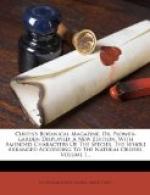The greater Spanish bell-flowred Jacinth. Park. Par. 123.
[Illustration: No 128]
There are few old gardens which do not abound with this plant; it bears great affinity to our Hare-bell, with which it appears to have been confounded by most Botanists. Parkinson thus discriminates it: “This Spanish bell-flowred Jacinth is very like the former English or Spanish Jacinth, but greater in all parts, as well of leaves as flowers, many growing together at the toppe of the stalke; with many short greene leaves among them, hanging doune their heads with larger, greater, and wider open mouths, like unto bels of a darke blew colour, and no good sent.” Park. Parad.
Though not remarkable for the fineness of its colours, or pleasing from its fragrance, it contributes with other bulbous plants to decorate the flower border or plantation in the spring, when flowers are most wanted.
It is very hardy, and increases abundantly by offsets; its seeds also ripen well.
[129]
AMARYLLIS VITTATA. SUPERB AMARYLLIS.
Class and Order.
HEXANDRIA MONOGYNIA.
Generic Character.
Corolla hexapetaloidea, irregularis. Filamenta
fauci tubi inserta,
declinata, inaequalia
proportione vel directione, Linn. fil.
Specific Character and Synonyms.
AMARYLLIS floribus pedicellatis, corollis
cuneiformi-infundibuliformibus,
petalorum exteriorum rachibus
interiorum margini
adnatis, scapo tereti, stigmatibus sulcatis.
Linn. fil.
AMARYLLIS vittata. L’Herit. Sert.
Angl. t. 15. Ait. Hort. Kew. p.
418.
[Illustration: No 129]
LINNAEUS, the Son, took much pains in new modelling the generic and specific characters of this genus; as may be seen in the Hort. Kew: Mons. L’HERITIER, when in England a few years since, saw this species, described and named it Vittata[1].
Of what country it is a native is not known with certainty, most probably of the Cape, was first introduced into England by Mr. MALCOLM.
Our figure was drawn from a fine specimen which flowered this spring with Messrs. GRIMWOOD and Co. Kensington.
It usually flowers in April or May, but may be forwarded by artificial heat.
It rarely puts forth offsets from the root, but readily produces seeds, by which it is propagated without difficulty.
When it blossoms in perfection it truly deserves the name of superb, which Mr. AITON has given it, the stem rising to the height of three feet or more, and producing from two to five flowers.
[130]
ALYSSUM UTRICULATUM. BLADDER-PODDED ALYSSUM.
Class and Order.
TETRADYNAMIA SILICULOSA.
Generic Character.
Filamenta quaedam introrsum denticulo notata. Silicula emarginata.




